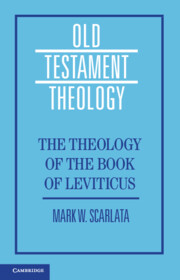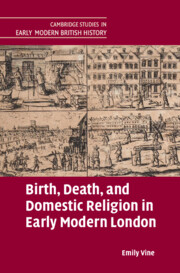Refine search
Actions for selected content:
393 results
12 - Joyce and the Everyday
-
-
- Book:
- The Cambridge Companion to James Joyce
- Published online:
- 14 August 2025
- Print publication:
- 21 August 2025, pp 200-215
-
- Chapter
- Export citation
6 - Liverpool 1974
-
- Book:
- Dreams and Songs to Sing
- Published online:
- 07 August 2025
- Print publication:
- 07 August 2025, pp 97-118
-
- Chapter
- Export citation
Chapter 5 - Dying and Deathbed Practices
-
- Book:
- Birth, Death, and Domestic Religion in Early Modern London
- Published online:
- 17 July 2025
- Print publication:
- 31 July 2025, pp 159-188
-
- Chapter
- Export citation
Chapter 6 - Domestic Religion in the Days After Death
-
- Book:
- Birth, Death, and Domestic Religion in Early Modern London
- Published online:
- 17 July 2025
- Print publication:
- 31 July 2025, pp 189-216
-
- Chapter
- Export citation
Chapter 4 - Daily Domestic Devotion and Preparation for Death
-
- Book:
- Birth, Death, and Domestic Religion in Early Modern London
- Published online:
- 17 July 2025
- Print publication:
- 31 July 2025, pp 125-158
-
- Chapter
- Export citation
Conclusion
-
- Book:
- Birth, Death, and Domestic Religion in Early Modern London
- Published online:
- 17 July 2025
- Print publication:
- 31 July 2025, pp 217-226
-
- Chapter
- Export citation
Introduction
-
- Book:
- Birth, Death, and Domestic Religion in Early Modern London
- Published online:
- 17 July 2025
- Print publication:
- 31 July 2025, pp 1-27
-
- Chapter
- Export citation

The Theology of the Book of Leviticus
-
- Published online:
- 18 July 2025
- Print publication:
- 07 August 2025

Birth, Death, and Domestic Religion in Early Modern London
-
- Published online:
- 17 July 2025
- Print publication:
- 31 July 2025
Death of the Gharīb: A Window towards a Regional Understanding of Displacement in the Middle East
-
- Journal:
- Comparative Studies in Society and History , First View
- Published online by Cambridge University Press:
- 17 July 2025, pp. 1-24
-
- Article
-
- You have access
- Open access
- HTML
- Export citation
Chapter 5 - Devon
- from Part I - Key Places and Events
-
-
- Book:
- Sean O'Casey in Context
- Published online:
- 23 June 2025
- Print publication:
- 10 July 2025, pp 57-66
-
- Chapter
- Export citation
Whose Grave’s This, Sir? An Ethico-Political Critique of Organized Resting Places
-
- Journal:
- Business Ethics Quarterly , First View
- Published online by Cambridge University Press:
- 27 June 2025, pp. 1-34
-
- Article
-
- You have access
- Open access
- HTML
- Export citation
Chapter 11 - The Possibility of Death
-
-
- Book:
- Heidegger's <i>Being and Time</i>
- Published online:
- 28 June 2025
- Print publication:
- 26 June 2025, pp 217-247
-
- Chapter
- Export citation
Epilogue
-
- Book:
- Neil MacCormick
- Published online:
- 22 May 2025
- Print publication:
- 12 June 2025, pp 566-569
-
- Chapter
- Export citation
Shedding light on Swiss health insurance costs in the last year of life
-
- Journal:
- Annals of Actuarial Science / Volume 19 / Issue 2 / July 2025
- Published online by Cambridge University Press:
- 15 May 2025, pp. 372-393
-
- Article
-
- You have access
- Open access
- HTML
- Export citation
V - Gandalf’s Fall and Return
-
- Book:
- Tolkien and the Mystery of Literary Creation
- Published online:
- 17 April 2025
- Print publication:
- 08 May 2025, pp 271-318
-
- Chapter
- Export citation
Motivations for choosing “home” as one’s preferred place of death: A scoping review
-
- Journal:
- Palliative & Supportive Care / Volume 23 / 2025
- Published online by Cambridge University Press:
- 24 April 2025, e102
-
- Article
-
- You have access
- Open access
- HTML
- Export citation
Chapter 6 - Death (As If)
- from Part I - Life and Death
-
-
- Book:
- Percy Shelley in Context
- Published online:
- 17 April 2025
- Print publication:
- 24 April 2025, pp 41-48
-
- Chapter
- Export citation
Investigation of the Effect of Death Anxiety on the Life Satisfaction of Individuals Living in the Earthquake Zone in Türkiye: The Disaster of the Century
-
- Journal:
- Disaster Medicine and Public Health Preparedness / Volume 19 / 2025
- Published online by Cambridge University Press:
- 10 April 2025, e86
-
- Article
- Export citation
